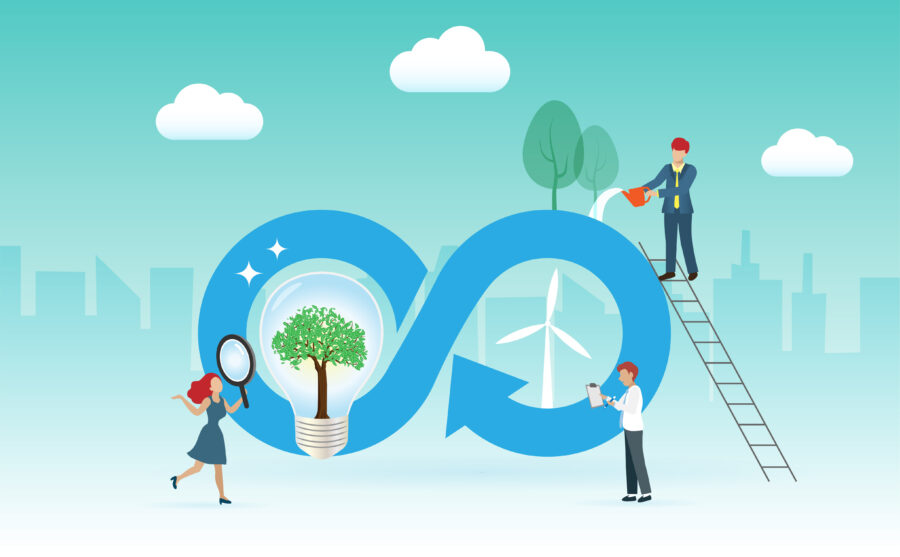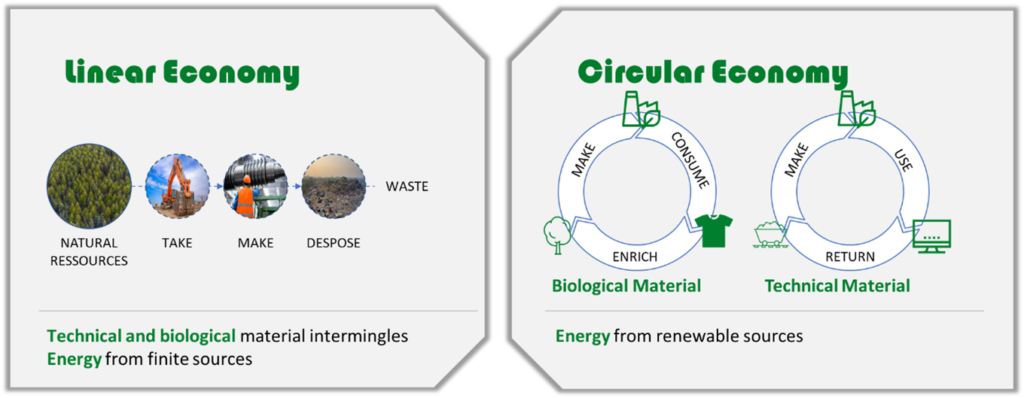
The Potential for Innovative Business Models in the Financial Industry with the Establishment of a Circular Economy
The threat of global warming has been a “hot” topic of discussion in recent weeks in the context of the UN Climate Change Conference. The focus of the discussions was on how the limitation of global warming to 1.5 degrees compared to the pre-industrial era, as stipulated in the Paris Climate Agreement, can be achieved. This presupposes a drastic reduction in CO2 emissions worldwide.
What has led us to our precarious situation has been, above all, our decades (if not centuries) of unsustainable living and economic activity. The World Commission on Environment and Development defines sustainable development as “development that meets the needs of the present without compromising the ability of future generations to meet their own needs”[1]. So, in order to act sustainably, i.e. to preserve this world for future generations, we need to take various measures now to stop man-made global warming. The interesting question is how to achieve this. If you consider that CO2 emissions are largely caused directly or indirectly by us consumers, you could, if you thought it through to its logical conclusion, assume that we would have to do away with the customer. Or the entire human being. As Prof. Michael Braungart, co-founder of the Cradle to Cradle principle, puts it: “The point is, traditional sustainability makes the customer the enemy.”[2]
This is where the concept of the Circular Economy comes in with its concept of decoupling growth and resource consumption. In contrast to linear value creation with its “take-produce-use-dispose” concept, the Circular Economy relies on a regenerative system, in which the concept of “waste” no longer exists. Instead, it becomes a valuable resource that remains in the cycle as a basis for further production. Two cycles are distinguished here, on the one hand the cycle for biological material (biosphere), on the other hand the cycle for technical material (technosphere). Residues in the biosphere are not only all materials that are biodegradable today, such as food scraps or paper, but also products such as shoe soles, car tyres, soap or textiles, where we cannot prevent parts of them from entering the environment either through abrasion or via water. All materials that enter the biosphere must be designed in such a way that they are biodegradable, so that they can then serve as organic material for other plants and thus remain part of the cycle. For the technosphere, the intention is to extend the lifespan of goods either by up-cycling or recycling or by passing them on among consumers (keyword sharing economy) so that they do not have to be taken out of circulation.[3]

The concept of the Circular Economy is also being pursued by the EU; the European Green Deal aims to create the transition to a “modern, resource-efficient and competitive economy”[5], with – in the words of the European Commission –:
- no net emissions of greenhouse gases by 2050
- economic growth decoupled from resource use
- no person and no place left behind
A total of EUR 1.8 trillion has been earmarked for the Green Deal.
This approach is not only environmentally sound, but also economically viable. The benefits of this approach are that the transition to a circular economy in Europe could increase GDP by €900 billion by 2030, raise the income of a typical European household by €3,000 per year and halve CO2 emissions compared to 2015[6].
Circularity is distinguished according to three “stages of development”.

The first class of models are the circular value recovery models. This class is about reusing used resources. Today’s examples are the use of waste as compost or the recycling of wastewater. This class also includes all of our deposit and recycling approaches for glass, metal or paper. The second class is best described as circular use models, where the aim is to extend the life of products or product components (e.g. by repairing or reusing them in other contexts), thereby increasing material and resource efficiency. The middle class includes approaches such as those of Grover, where the customer can rent numerous electronic devices such as iPads or headphones, insurance cover included. After use by the customer, they can return the devices and they are cleaned and re-rented (R3 Re-Use). The third class, where the strongest circularity is achieved, is circular design and production models, where the aim is to design products from the outset so that they can be easily refurbished and reused or returned to the biological cycle – in short, where the concept of waste in the traditional sense no longer exists. Concepts where circularity by design is pursued are rather rare, but will increase in the future. For example, researchers at the Rheinisch-Westfälische Technische Hochschule Aachen (RWTH) have developed a method of incorporating carbon dioxide as a resource into the production process of textile fibres, closing the carbon cycle[8].
What do these varying degrees of circularity mean for businesses and how can financial institutions support these approaches?
A contemporary example of the “highest” level of circularity are machinery pools, associations of agricultural enterprises that jointly acquire and use agricultural machinery, e.g. a combine harvester[9]. Although the primary motivation for these associations is probably cost saving, such a system is at the same time very sustainable, as the machines are much better utilized and no resources are wasted by actually unnecessary extra production. However, this concept is not only useful for agricultural machines: today’s factories often suffer from under-utilization, capacities remain unused[10]. If we combine this initial situation with the general trend toward product-as-a-service, new business models could emerge at the “highest” level of circularity if companies in the technosphere no longer sell new machines, but only the services provided with the machine. In this system, product manufacturers would no longer have to purchase machines, but could rent production capacities. The machines themselves could, for example, consist of used parts and at the end of their life cycle be partly reused by the manufacturer – who is and remains the owner – or rather, the raw materials bound up in them. A preliminary stage of such a system today is, for example, the company Xometry, which provides a marketplace through which companies can make their unused production capacities available to other companies and private individuals.
For the machine manufacturer, new financing needs arise in such a system, as there is no sale of produced machines to cover production costs, but rather the inflow of funds is spread over a longer period of time. Here, banks can support the new type of financing and, through IoT-based payments, offer repayments based on the quantity of goods produced with the machine, for example, as Commerzbank or Munich Re are already doing. In the latter example, laser cutting machines from TRUMPF are financed by Munich Re and physically delivered to the customer for production, but remain the property of the manufacturer and are maintained by it[11].
At the intermediate level of circularity, the product-as-a-service trend can also be observed, e.g. in the form of subscription models even for products that fall more into the consumer segment for private customers (e.g. cameras, loudspeakers or headphones).
For companies in both classes, the question of their valuation also arises, since their products now turned into assets can no longer be written off in the traditional way, but more or less retain their value and are reused or become raw materials again. This could also be a field of activity for banks – valuation of assets (raw materials). At the same time, the change in payment behaviour (embedded finance) resulting from subscription models or machine payments also offers a much higher level of customer interaction for companies and banks. There are also various approaches emerging for insurance companies that can insure the use of products obtained via a subscription. Further support may also be needed in the area of raw material procurement to ensure that newly procured raw materials originate from sustainable sources.
The topic of sustainability and the circular economy offers enormous potential for banks to support corporates with existing services (embedded finance, financing) as well as new services (new valuation of corporate assets (raw materials)) and at the same time to interact much more closely with end customers.
Further information on the Circular Economy can be found in Commerzbank’s Open Banking Whitepaper “How API based Ecosystems can serve Circular Economy“[12], which was produced in cooperation with the Business Engineering Institute St. Gallen.
[1] https://www.are.admin.ch/are/en/home/media/publications/sustainable-development/brundtland-report.html
[2] https://businesscircle.at/news/banken-versicherungen/das-falsche-perfekt-machen-und-das-perfekt-falsch/
[3] https://mediaserver.htwk-leipzig.de/videos/zukunft-stadt-c2c/iframe/#slide
[4] https://www.datadriveninvestor.com/wp-content/uploads/2018/10/circular-economy.jpg
[5] https://ec.europa.eu/info/strategy/priorities-2019-2024/european-green-deal_en
[6] https://ellenmacarthurfoundation.org/regions/europe
[7] Okorie, Okechukwu & Salonitis, Konstantinos & Charnley, Fiona & Turner, Chris & Moreno, Mariale & Tiwari, Ashutosh. (2018). Digitisation and the Circular Economy: A Review of Current Research and Future Trends. Energies. 11. https://www.researchgate.net/publication/328662037_Digitisation_and_the_Circular_Economy_
A_Review_of_Current_Research_and_Future_Trends.
[8] https://op.europa.eu/de/publication-detail/-/publication/ca9846a8-6289-11ea-b735-01aa75ed71a1
[9] https://www.maschinenring.de/leistungen/maschinen/gemeinschaften
[10] https://archive.curbed.com/2015/9/29/9916234/make-time-distributed-manufacturing-machine-design
[11] https://www.munichre.com/de/unternehmen/media-relations/medieninformationen-und-unternehmensnachrichten/medieninformationen/2020/2020-10-14-pay-per-part.html
[12] https://developer.commerzbank.com/shared/documents/commerzbank-open-banking-whitepaper-2021.pdf
